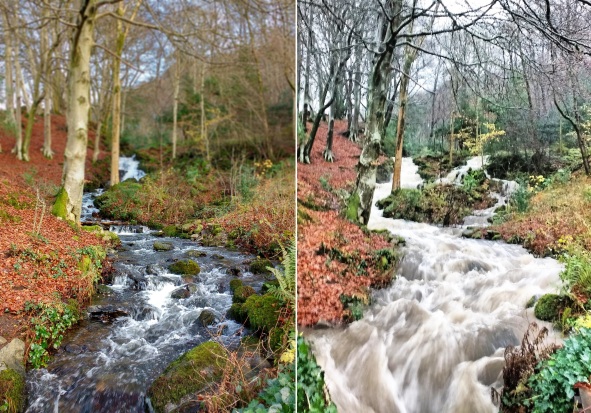
This blog post is written by Ros Nicholls, a 3rd year PhD student in the School of Geography, Geology and the Environment at the University of Leicester. Ros’ research focuses on sediment transport in rivers. In this blog post, she tells us about her placement with a team of National Trust Rangers in the Lake District National Park. Ros has also written blogs on her fieldwork experiences and a placement to Kenya, so make sure to check them out too!
During late November, I was lucky enough to be able to visit the Lake District National Park for a week to experience the day-to-day life of the team of National Trust Rangers based at St Catherine’s, just outside Windermere. As someone who is particularly interested in conservation and environmental education, I found it a really interesting and useful week. When I was checking what I should bring along for the week I was told to “bring nice weather”. Well, I failed spectacularly at that as I spent most of the week in wellies and full waterproofs. Luckily for me, all the rain made things very interesting for someone who studies rivers!

The babbling brook outside St Catherine’s which became a raging torrent after Wednesday’s heavy rain.
Throughout the week, I worked alongside several of the rangers in the team. At the start of the week, James and John took me to visit lots of different National Trust properties including lake shore areas, woodlands, and farm land. These site visits gave me the chance to learn about the different types of land that the Trust are responsible for managing. They also helped me to understand the problems they face with land management, including tourist pressures, grazing pressures, and flooding.
A sign to notify visitors about the new fence and reed bed restoration along the Windermere’s shore at Fell Foot; Witches’ mark on a barn door. Such carvings were made to ward off evil spirits.

A rare glimpse of some sun over Ullswater on an otherwise rainy Tuesday!
Cattle grazing in a woodland pasture scheme; Coppiced alder with a pile of brash in the background. Brash is used as a natural manure for the forest, and also offers a home to and food for many woodland animals; A pollarded ash tree with young growth around its base. If there isn’t any young growth around the base of a tree, it can show that the area is over grazed.
As well as going on some site visits, I was also involved with some maintenance work, which included clearing blocked drains of mud and leaves, hanging a gate, and removing old tree tubes from a woodland planting site so they could be reused or recycled. On arrival at Skelghyll Woods, water was running down the road, which highlighted that the drains further up the track were blocked and not effectively draining water into the neighbouring stream. During winter, water running onto the road is an ice risk, so we wanted to solve this problem before any cold snaps arrived. The results of our drain clearing work were immediately visible, and by the time we had finished at the site, the road no longer resembled a river!
Freshly cleared drain and newly hung gate at Skelghyll Woods.
Working outside has many perks, including being able to walk the Champion Tree Trail during your lunch break, and having afternoon tea breaks in very scenic spots! This tree is the tallest Giant Sequoia in Cumbria, measuring a whopping 54m tall. The valley is Scandale, which is a very peaceful valley just outside of Ambleside.
I also got the chance to be involved in some woodland work with Liam, the Woodland Ranger. Although our planned work in the Langdale Valley on the Wednesday had to be cancelled due to heavy rain (it rained like I’ve never seen before!) and flooding, the inclement weather gave me the opportunity to experience some of the challenges associated with working in an environment like the Lake District! We were able to watch a shear crack in the base of a tree open and close in the gusts of wind, highlighting the importance of carrying out tree safety checks. Luckily, this particular tree was away from roads and buildings, so if it were to blow over, it hopefully wouldn’t cause any harm. Once there is a nice spell of weather, the tree will be safely felled.

A rather bleak Langdale. Luckily we got out before the roads were impassable due to flooding.
On the Friday, the sun finally shone, and we were able to get out and do some tree felling work. I was tasked with preventing walkers on a public footpath from entering the area while the chainsaws were on, and then helping to clear the branches off the footpath once the tree was safely felled. We also performed some tree safety checks on the shores of Windermere in the afternoon, after which I was able to see the paperwork for the safety checks. As with many jobs, being a Ranger comes with lots of paperwork!
Tree felling work at Post Knott; A beech tree infected with Ganoderma applanatum – known as artist’s fungus as you can draw on the base of it with sticks!
Overall, I had a fantastic time on my work placement with the National Trust Rangers. The team who I worked with were very friendly and welcoming, and I learnt a lot during the week. I can definitely see myself working in this kind of role once in the future! Thank you to the National Trust team at St Catherine’s for having me and to CENTA for providing the funding which allowed me to go on the placement.

A work place with a view!












One thought on “A glimpse into the future?”